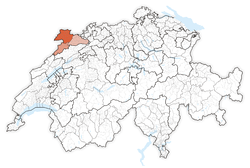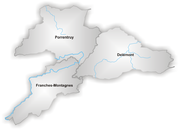Canton of Jura
| République et Canton du Jura | |||
|
|||
 |
|||
| Coordinates | |||
| Capital | Delémont | ||
| Population | 70,134 (12/2009)[1] | ||
| - Density | 84 /km² (217 /sq mi) | ||
| Area | 838 km² (324 sq mi) | ||
| Highest point | 1,302 m (4,272 ft) - Mont Raimeux | ||
| Lowest point | 364 m (1,194 ft) - Allaine at Boncourt | ||
| Joined | 1979 | ||
| Abbreviation | JU | ||
| Languages | French | ||
| Executive | Conseil d'Etat (5) | ||
| Legislative | Parliament (60) | ||
| Municipalities | 64 municipalities | ||
| Districts | 3 districts | ||
| Website | JU.ch | ||
| View map of Jura | |||
|---|---|---|---|
The Republic and Canton of the Jura (French: République et Canton du Jura), also known as the Canton of Jura or Canton Jura, is one of the Cantons of Switzerland. It is the newest (created in 1979) of the 26 Swiss cantons, located in the northwestern part of Switzerland. The capital is Delémont. It shares borders with the Canton of Basel-Landschaft, the Canton of Bern, and the French département of Doubs.
Contents |
History

The King of Burgundy donated much of the land that today makes up Canton Jura to the Bishop of Basel in 999. The area was a sovereign state within the Holy Roman Empire for more than 800 years. After the Treaty of Westphalia in 1648 the Jura had close ties with the Swiss Confederation. At the Congress of Vienna (1815), the Jura was given to the canton of Bern. This act caused dissention. The Jura was French-speaking and Roman Catholic, whereas the canton of Bern was mostly German-speaking and Protestant. The people of the Jura region called for independence. After a long struggle, which included some arson attacks by a youth organisation Les Béliers, a constitution was accepted in 1977. In 1978 the split was made official when the Swiss people voted in favour of it, and in 1979 the Jura joined the Swiss Confederation as a full member. It celebrates its independence from the Canton of Bern on the 23rd of June. However, the southern part of the Jura region, which is also predominantly French-speaking but has a Protestant majority, opted not to join the newly-formed canton, and instead remained part of the Canton of Bern. This decision may seem somewhat strange from a linguistic standpoint. However this choice may have been influenced due to the fact that the Canton of Bern is financially richer and is at the heart of Federal power in Switzerland. The area is now known as Bernese Jura. The word Jura, therefore, may refer either to Canton Jura, or to the combined territory of Canton Jura and the Bernese Jura. Switzerland as a whole, often presents the latter from a touristic standpoint with documentation easily available in French or German.

On creation, the canton adopted the title Republic and Canton of the Jura. Other cantons in Switzerland using the title "Republic and Canton" are Ticino, Canton Geneva, and Canton Neuchâtel. In each case the title asserts the autonomy of the canton and its nominal sovereignty within the Swiss Confederation.
Since 1994 the question of the Jura region has again been topical. In 2004 a federal commission has been proposing that the French-speaking southern Jura be reunited with the Canton of Jura, as the language question now seems to be more important than the denominational. A possible solution would be to create two Half-Cantons as reunification with the creation of only a single Canton would mean a complete restructuring of the Jura's current political system with the Cantonal capital being transferred from Delémont to Moutier.
Geography
Canton Jura lies in the northwest of Switzerland. It consists of parts of the Jura mountains in the south and the Jura plateau in the north. The Jura plateau is hilly and almost entirely limestone. The districts of Ajoie and Franches-Montagnes lie in this region. The term "Jurassic" is derived from the Jura Alps, strata of which date to that era.
To the north and the west of the Canton lies France. The canton of Solothurn and Basel-Landschaft are to east of the canton, while the canton of Bern bounds the Jura to the south. The River Doubs and the river Birs drain the lands. The Doubs joins the Saône and then the Rhône, whereas the Birs is a tributary to the Rhine.
Political subdivisions
Districts

Jura is divided into 3 districts:
- Delémont (German: Delsberg) - capital: Delémont
- Porrentruy (German: Pruntrut) - capital: Porrentruy
- Franches-Montagnes (German: Freiberge) - capital: Saignelégier
Municipalities
There are 64 municipalities in the canton (As of 2009[update]).[2]
Demographics
The population is almost entirely French-speaking. Just one municipality is German-speaking: Ederswiler. The majority of the population is Roman Catholic (75% as of 2000[update]) with a small Protestant minority (13%).[3] The population of the canton (as of 31 December 2009) is 70,134.[1] As of 2007[update], the population included 8,195 foreigners, or about 11.8% of the total population.[4]
Economy
Agriculture is important in Canton Jura. Cattle breeding is significant, but there is also horse breeding. The main industries are watches, textiles and tobacco. There is a growing number of small and middle-sized businesses. Nevertheless, it remains one of the weakest cantons economically, at only 30% of the Swiss average. This is also evident from the number of houses - including the historically valuable - which are uninhabited, and have been left to decay.
Culture
The eau de vie Damassine is one typical produce of the Ajoie area. (see [1] Terroir Jura and [2] Jura Infos)
See also
References
- ↑ 1.0 1.1 Swiss Federal Statistical Office, MS Excel document – Bilanz der ständigen Wohnbevölkerung nach Kantonen, Bezirken und Gemeinden (German) accessed 25 August 2010
- ↑ "Liste officielle des communes de la Suisse - 01.01.2008". http://www.bfs.admin.ch/bfs/portal/fr/index/infothek/nomenklaturen/blank/blank/gem_liste/03.Document.90142.xls. Retrieved 15 décembre 2008.
- ↑ Federal Department of Statistics (2004). "Wohnbevölkerung nach Religion" (Interactive Map). http://www.bfs.admin.ch/bfs/portal/de/index/themen/01/05/blank/key/religionen.html. Retrieved 2009-01-15.
- ↑ Federal Department of Statistics (2008). "Ständige Wohnbevölkerung nach Staatsangehörigkeit, Geschlecht und Kantonen" (Microsoft Excel). http://www.bfs.admin.ch/bfs/portal/de/index/themen/01/02/blank/key/raeumliche_verteilung/kantone__gemeinden.html. Retrieved November 5, 2008.
Further reading
- Ganguillet, Gilbert: Le conflit jurassien. Un cas de mobilisation ethno-régionale en Suisse, Zürich 1986.
- Harder, Hans-Joachim: Der Kanton Jura. Ursachen und Schritte zur Lösung eines Schweizer Minderheitenproblems, Frankfurt am Main 1978.
- Hauser, Claude: Aux origines intellectuelles de la Question jurassienne. Culture et politique entre la France et la Suisse romande (1910–1950), Diss. Fribourg 1997.
- Henecka, Hans Peter: Die jurassischen Separatisten. Eine Studie zur Soziologie des ethnischen Konflikts und der sozialen Bewegung, Meisenheim am Glan 1972.
- Jenkins, John R.G.: Jura Separatism in Switzerland, Oxford 1986.
- Ruch, Christian: Struktur und Strukturwandel des jurassischen Separatismus zwischen 1974 und 1994, Bern 2001.
- Schwander, Marcel: Jura. Konfliktstoff für Jahrzehnte, Zürich/Köln 1977.
- Steppacher, Burkard: Die Jurafrage in der Schweiz, München 1985.
External links
- Republic and Canton of Jura (French) official site
- Jura Tourism
- Watch Valley
- Official Statistics
|
|||||

